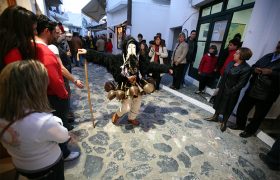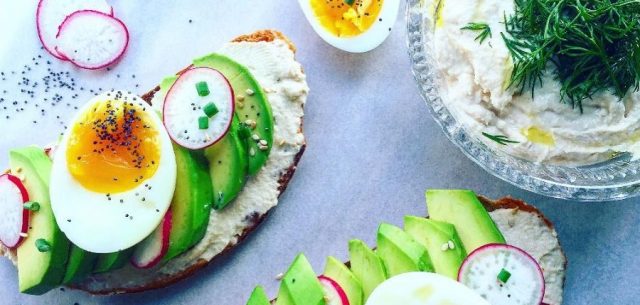Greek Regional Easter Recipes by Diane Kochilas

Acclaimed chef, cookbook author, TV host and passionate culinary ambassador Diane Kochilas dons her apron to create Easter delicious recipes and an Easter menu.
Cretan Braised Lamb & Greens with Egg-Lemon Sauce – Arni Fricasse
This dish is made all over Greece, but this particular version, the original of which calls for a wild Cretan chicory called askolimbrous is from Crete. You can use any sweet or even bitter green for this.

photo credits: www.dianekochilas.com
Ingredients (serves 4)
- 1/2 cup Greek extra-virgin olive oil
- 2 1/2 pounds lamb shoulder cut into stewing pieces
- 2 cups coarsely chopped onion
- 2 1/2 pounds trimmed greens any combination of spinach, chard, chicory, sorrel, wild fennel, vine shoots, bryony, or thistles
- Salt and pepper to taste
For the sauce
- 2 large eggs
- Fresh strained juice of 2 lemons
Instructions
-
Heat the olive oil in a large wide stewing pot and add the lamb. Brown on all sides over medium-high heat. Remove and set aside. Add the onions to the pot and saute, stirring, over medium heat until translucent, about eight minutes. Place the meat back in the pot and stir together with the onions. Season with salt and pepper. Add enough water just to cover the lamb. Cover the pot and simmer for about one and a half hour.
-
In the meantime, wash and drain the greens. Bring a large pot of lightly salted water to boil and blanch the greens for a few minutes to wilt. Drain and rinse under cold water in a colander. Add the greens to the lamb and continue cooking for another half hour. Add more water during cooking if necessary. There should always be liquid in the pot.
-
Make the avgolemono: Using a wire whisk, beat the eggs and lemon together until frothy and then take a ladleful of pot juices and add them to the egg mixture in a slow steady stream, whisking all the while. Pour the avgolemono into the pot, remove from heat, and tilt pan so that the sauce is evenly distributed. Serve immediately.
Aegean Island Easter Goat Stuffed with Rice, Pine Nuts & Raisins – Byzanti
This wonderful dish, from Kalymnos in the Dodecanese, is a classic Greek island Easter recipe. Easter in the Aegean is a feast not of spit-roasted lamb—the cliché image of the Greek paschal table—but of stuffed, wild island goat. Spring herbs, especially wild fennel, nuts, rice, spring onions, and sometimes cheese go into the mix, which is then stuffed into the cavity of the goat before baking it, typically in a wood-burning oven. I have never been able to trace the root of the name of this unique stuffed island goat recipe, which hails from the remote island of Karpathos and is seasoned most unusually with cloves, a spice reserved for the pastry kitchen in most of the rest of Greece.

photo credits: www.dianekochilas.com
Ingredients (serves 10)
- 1 whole milk-fed goat about 10 pounds/5 kilos, plus viscera (liver, kidneys, and lungs)
- 3 lemons
- Salt and pepper to taste
- 1 cup extra virgin Greek olive oil
- ½ cup unsalted butter
- 10 scallions finely chopped
- 4 garlic cloves finely chopped
- 1 tablespoon cumin powder or more to taste
- 1 tablespoon cinnamon powder
- ½ tablespoon ground cloves
- 4 cups short grain rice
- 4 cups tomatoes plus juices finely chopped
- 1 cup pine nuts toasted
- 1 cup golden raisins
- 3 cups fresh dill finely chopped
Instructions
-
Preheat the oven to 375˚F (190C).
-
Rinse the goat very well inside and out. Pat dry. Cut the lemons in half and rub them over the body and inside the cavity of the lamb, squeezing as you go. Season the lamb or goat generously with salt. Set aside.
-
Rinse, drain, and finely chop the liver, kidneys and lungs. Heat half the olive oil and butter in a large, wide pot over medium heat and cook the chopped viscera until lightly browned. Add the scallions and garlic and cook until soft. Add the rice and stir to coat. Add the spices and stir for a minute or so to release their aroma. Pour in the tomatoes. Season generously with salt and pepper. Cook until the liquid is reduced by about half. The mixture should be loose. Add the pine nuts, raisins, and dill. Set aside to cool.
-
Carefully stuff the cavity of the goat with the rice mixture. Sew it closed with a large needle and thread. Rub the goat with remaining butter and olive oil and season the outside generously with salt and pepper. Roast uncovered for one hour to brown. Reduce heat to 300˚F/150˚C and continue roasting slowly for another 2 to 3 hours, or until the goat is very tender.
Big Flavors, Small Plates: Greek Spring Meze Recipes – Online Cooking Class with Diane Kochilas
Mezedes (pl.) are the small plates with big flavor that are a longstanding tradition on the Greek table. Meze cooking is vibrant and varied. A meze spread is meant to have a little of everything, for everyone, and that’s the philosophy behind this class. We will be making a spanakopita dip, classic Greek mezedes, a bright and beautiful black-eyed pea salad and pan-fried cheesy delight!
Menu:
– Spanakopita Dip
– Classic Keftedes
– Black Eyed Pea Salad with Pomegranate and Herbs
– Pan-Fried Halloumi Drizzled with Honey













